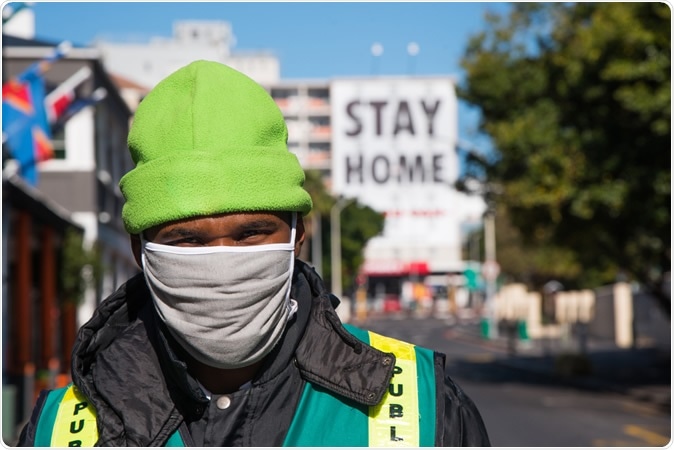A new study published on the preprint server medRxiv in April 2020 reports that lockdowns in South Africa may not flatten the curve as expected.
The study investigated the effect of the various interventions in South Africa on the outbreak, analyzing trends in South Africa before and after the national lockdown, which started on March 27, 2020. Africa has so far reported over 38,000 cases, a small number compared to the 3.25 million global cases as of April 30, 2020. South Africa has reported over 5,600, with Egypt and Morocco close behind.
At the time of the study, the case numbers in Africa were about 20,000, with 3,034 of those in South Africa.

Cape Town, South Africa. 27 April 2020. Cape Town's busiest street is empty during one of the world's strictest national COVID-19 (coronavirus) lockdown. Image Credit: Micha Serraf / Shutterstock
Locking down to flatten the curve
When the signs of the coronavirus pandemic appeared in Africa, many of its countries, especially South Africa, were quick to recommend global social distancing measures, enforcing lockdowns and bringing economic, educational, and leisure activities to a standstill. They also reduced transportation options.
However, the harsh socio-economic conditions posed a significant challenge to compliance with these interventions - the hand-to-mouth lifestyle of a large group of individuals meant that economic lockdown would only meet with limited cooperation.
The researchers point out, "African countries are under particular pressure due to economic constraints on both national and personal levels. Besides strong repercussions on national economic productivity expected for any large-scale lockdown, a large fraction of the population is unable to fully comply with severe lockdown measures due to their personal financial situation."
Slower but continuing exponential growth threatens Africa
The researchers performed a quantitative analysis of the dynamic changes in case numbers, as reported by both the World Health Organization and Johns Hopkins University through April 18, 2020.

2 April 2020 - Cape Town, South Africa: Aerial view of empty streets in Cape Town, South Africa during the Covid 19 lockdown. Image Credit: fivepointsix / Shutterstock
Initially, case numbers were growing exponentially, with a doubling time of about 2.5 days. After lockdown, the number of cases continued to double, albeit over a more extended period of 18 days, showing that the growth in case numbers remained exponential. This was in contrast to Hubei (China), which reported an arrest in case growth rates after enforcing a massive lockdown.
The study points out several risk factors for a rebound in cases if the lockdown is to be removed. "Across the African continent, national economic constraints, individual poverty, low health literacy rates, weaker health care systems, and cultural practices lead to reduced option spaces on personal and governmental levels and may all contribute to more severe consequences of the COVID-19 outbreak and negatively influence containment as well as recording, testing, and medical treatment."
Why the slowing occurred
A switch to a slower growth rate on the date of the official lockdown could be attributed to several largely unknown factors, researchers say. These include an increase in the number of people being tested per day, small fluctuations that normally occur at the onset of an epidemic, and individual efforts to practice social distancing measures even before the lockdown was officially announced. In addition, the early cases were probably detected after the onset of symptoms in contrast to pre-emptive testing of contacts and detection of asymptomatic cases.
The decline in South African cases is reflected in the statistics for the whole continent because South African cases comprise such a large share of the whole. However, the time and case trends are extremely uneven across the continent, as is case reporting and testing rates.
The movement simulator results
The study also included a movement simulation model for the Nelson Mandela Bay Municipality, where well over a million people stay. The computational model suggests that even if the current lockdown measures are kept in place until the end of April, with current compliance levels, they would be unsuccessful in achieving the aim of preventing case overload on the fragile healthcare system with a highly limited capacity for intensive care.
The risk of COVID-19 to South Africa is immense, with its 7.7 million HIV patients and over 320,000 tuberculosis patients, which is 20 times that in Europe. The persistence of exponential growth could signal the potential for an Italy-like situation in the country.
Researchers comment, "A large-scale outbreak and massive ICU overload may have drastic consequences for the country as a whole, including societal and economic but also psychological, and ethical issues. "
In contrast, the study showed that if the lockdown was entirely lifted on May 1, the number of infected cases would immediately rise, and the number of critical cases would accumulate and overwhelm the ICU capacity of the state.
Even if the lockdown was lifted by 25% two weeks later on May 15, case numbers would still rise sharply, and ICUs would be overloaded by early June.
If current lockdown conditions were maintained, the outbreak would be slowed. Yet, if a certain percentage of the population refused to comply, the epidemic would not be contained long-term, and risk of ICU overload would be present, although by a small margin.
The way ahead
The answer could be to impose stronger, more specific, and more long-term measures while simultaneously boosting compliance through education. The study says that these could "constitute a viable option for interventions for regions in South Africa and potentially for large parts of the African continent."
This will help flatten the curve such that the total number of patients who develop very severe or critical COVID-19 is less than the total capacity of local intensive care units, and perhaps contain the epidemic by June 2020.
Such measures should be adopted only after a careful analysis of the data and the use of predictive models that can throw up answers about how long and at what level the lockdown measures should continue.
Important Notice
medRxiv publishes preliminary scientific reports that are not peer-reviewed and, therefore, not be regarded as conclusive, guide clinical practice/health-related behavior, or treated as established information.
Sources:
Journal reference: